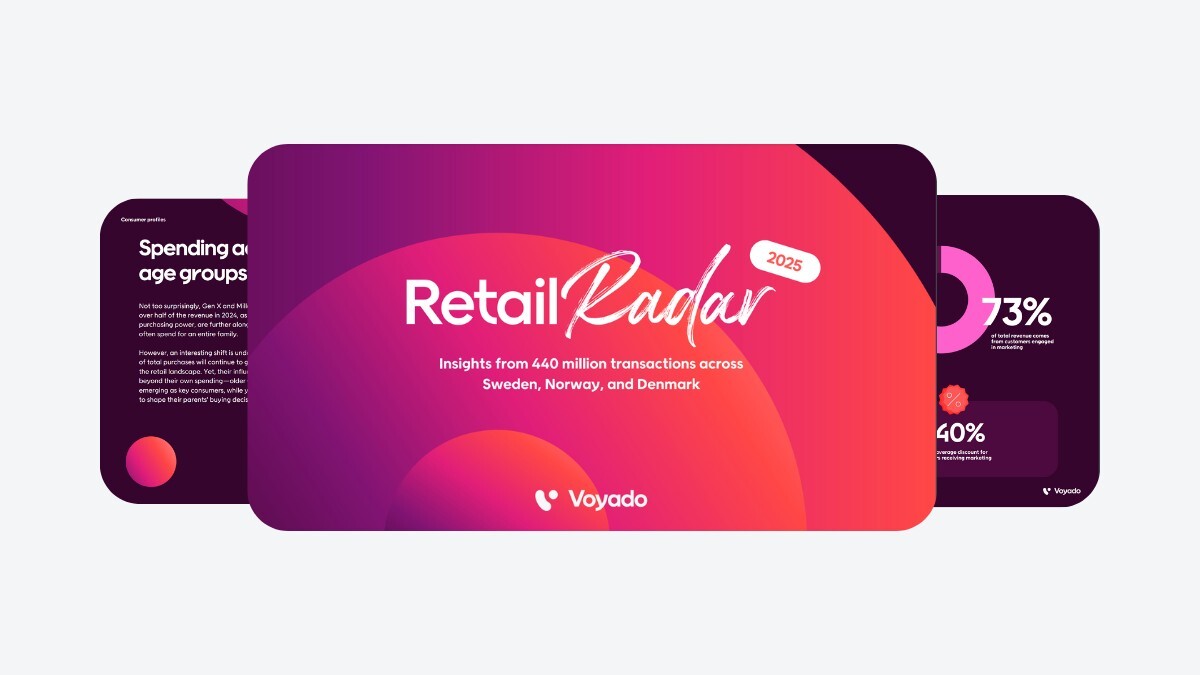Consumer Behavior: What Are the Trends?
Voyado’s most recent Retail Radar report reveals significant shifts in consumer behavior compared to last year. Data from Voyado shows that consumers with customer loyalty systems in place, experienced a 7,4% increase in sales revenue in 2024.
The report covers several other insights into consumer trends including:
- More items are being discounted, yet discounts aren’t driving sales
- Returns are increasing, especially during peak shopping periods
- Customer loyalty is more critical than ever
- Revenue is rising in most industries, although some sectors are struggling
- In-store sales are growing but online sales are declining
These trends suggest that retailers need to rethink their strategies to meet changing customer expectations.
Why More Discounts Aren’t Driving More Sales
A noticeable trend is the increase in average discount rates, particularly in physical stores, where more items are discounted compared to online. However, despite this, shoppers aren’t buying discounted items as much as they used to. This creates a major challenge for retailers, making it difficult to clear in-store inventory at the end of the season.
When retailers heavily discount products in stores that are no longer sold online, two key issues arise:
- Poor Product Allocation: Many discounted items could sell well online, but if they’re only available in physical stores, online shoppers never see them. This misalignment means potential sales are lost.
- Delayed Sales: In a recession, consumers are more cautious when spending. If sales aren’t happening early in the season, retailers struggle to move inventory before markdowns become unavoidable.
Automation is key to navigating these challenges. With the constant flow of new items, managing product allocation manually is unsustainable. The answer is to have a well-functioning order management system (OMS) in place. This system ensures that products are available in the right place at the right time, reducing the need for large end-of-season discounts. Clear communication with customers is key, and it is important to inform customers about product availability and locations on time.

Key Strategies Retailers Should Focus on
As mentioned above, retailers will benefit from implementing an efficient order management system. Smart product allocation and better sales strategies are essential to retailers. During a recession, it's even more important for retailers to get the fundamentals right, such as implementing personalization early in the product lifecycle and targeting the right customers. They must also keep a strong assortment strategy to balance inventory effectively across both physical and online stores.
By prioritizing these key areas, retailers can drive engagement, foster long-term customer relationships, and maintain stability even in challenging economic conditions.
How Loyalty Generates Revenue Growth
Retailers with customer loyalty systems like Voyado Engage are seeing significantly better results when it comes to sales, as they already understand the value of personalization and customer retention. Customers who engage with loyalty communications generate 73% of total market revenue. Compared to non-engaged shoppers, they spend more, return fewer items, and receive better discounts.
The Rising Wave of Returns
The return of products has become more pronounced as we navigate an ongoing recession. This is particularly true during peak shopping periods like Black Friday, Christmas, and summer sales.
A key factor driving this increase is the extension of discount periods. Retailers are no longer limiting major discount events to a single day or weekend. For example, Black Friday is now extended to a whole “Black Month”, and seasonal sales stretch for weeks. As a result, especially during a recession, shoppers are returning items they bought at full price, only to repurchase them at a lower price during discount periods. To minimize the hassle and cost of returns and speed up the handling process, making the product sellable again, businesses can benefit from having a smooth return management system in place. Not only does a well-functioning return system improve the customer journey, but it also increases profitability. Additionally, implementing a strong loyalty program can further discourage returns and enhance customer retention.

Which Industries Are Not Keeping Up and Why?
Although most industries have seen a significant revenue increase in 2024 compared to 2023, some struggle to keep up. One of the hardest-hit industries is kids, which has seen an 8% decline in revenue since last year.
The kids industry is facing challenges primarily due to market saturation and shifting consumer behaviors. Additionally, external trends such as declining birth rates and the rising demand for second-hand kids’ clothes and products are affecting the market. The second-hand market has become a powerful competitor, and some brands are already trying to keep up by launching second-hand sections and offering customers vouchers or loyalty points for returning used items.
This trend isn’t limited to kids’ clothes and products, and other industries are likely to be affected soon. For retailers, the message is clear: adapt quickly or risk being left behind. Those who fail to figure out how to compete with the second-hand market could soon find themselves struggling to stay afloat.
Why Online Sales are Declining Despite an Increase in Spending
In 2024, in-store sales grew by almost 12%, whilst online sales did the opposite and fell by 3,7%. A combination of economic recession, forcing consumers to be more mindful of their spending, and the growing influence of Gen Z as shoppers, appear to be driving this shift. As does the increase in POS-integrated loyalty programs that provide customers with a better in-store experience.
Shopping habits are changing. In the past, consumers may have shopped both online and in-store. However, when budgets are tighter many prioritize in-store shopping, as it offers a much more rewarding experience. For younger generations, buying a product online is no longer enough. These shoppers are seeing thousands of products marketed on social media, but have begun to crave an added element (such as an engaging store experience) to get a “kick” out of their purchase and integrate with brands in real life. As Gen Z, our largest population group, is expected to dominate global spending by 2034, retailers must engage with these consumers to stay competitive. This includes offering more than just products, delivering meaningful brand experiences, and fostering authentic relationships.
To get more insights download the full Retail Radar report from Voyado here.
At Avensia, we’re experts at implementing loyalty programs, order management systems, and return management solutions. We partner with leading providers such as Voyado, Fluent Commerce, Omnium, and Inretrn to help businesses stay ahead of evolving customer trends. Want to discuss how your business can best adapt to the changing consumer? Get in touch with our customer experience experts today.











